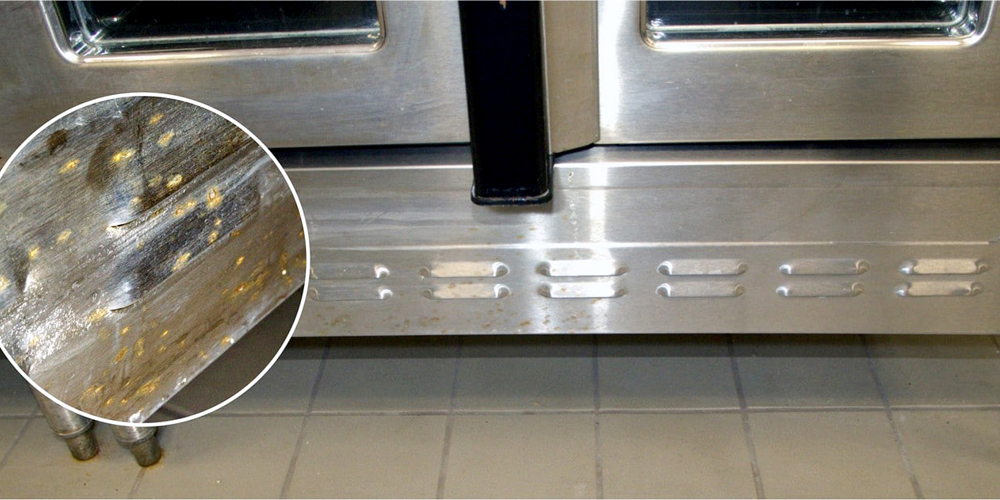An unknown substance was tracked onto a newly installed floor of the kitchen of a school cafeteria. A number of cleaning agents were unsuccessfully utilized in order to remove this substance, including all purpose cleaners, lacquer thinner, paint thinner, and a citric-based solvent. Diluted muriatic (hydrochloric) acid was finally used to remove this substance.
During the cleaning process, it was reported that some of the muriatic acid solution was splashed upon stainless steel appliances and components within the kitchen. The next day, corrosive damage was observed on stainless steel surfaces.
A renovation company inspected the damage and reported that the stainless steel had pitting corrosion and that the components could continue to corrode indefinitely. They claimed that acid vapors present from the cleaning had the potential to cause damage to seemingly unstained areas at any time. Therefore, they concluded that all stainless steel kitchen components needed to be replaced.
ESi was retained to independently inspect the damage and evaluate metallurgical aspects of the staining event that had occurred.
Our Approach
In order to characterize the damage to the stainless steel components, ESi performed a number of analysis activities. An on-site inspection was performed. A portable X-ray Fluorescence (XRF) analyzer was used to determine the specific stainless steel alloy of each component and identify chemical elements present in stained versus unstained areas. Litmus paper was also used to determine whether the surfaces were acidic, neutral, or basic.
Laboratory analysis was also performed, in which ESi replicated the staining on exemplar stainless steel panels and cleaned the panels with a nitric acid solution.
ESi’s investigation and analysis reached different conclusions from those of the renovation company that recommended complete replacement of stainless steel components. No evidence of pitting corrosion was found. XRF analyses revealed the presence of chlorine (from the muriatic acid) in regions of staining only. These results indicated that the claim of acid vapors having the propensity to cause further damage in areas that were not already visibly stained was highly unlikely, since the chlorine was not present in unstained areas.
Testing of pH determined that stainless steel surfaces were neutral, which further suggested that continued corrosion was unlikely in areas that were not already visibly stained.
Stainless steel has a protective (passive) surface layer, predominantly composed of chromium oxide, on its surface that provides the ability to resist corrosion and other chemical penetration. In the presence of a corrosive agent, this protective layer can eventually be penetrated, allowing corrosive damage to propagate through the material. However, if the protective layer is restored, the stainless steel regains its corrosion-resistant properties. This process is known as re-passivation.
The exemplar testing replicated the staining observed in the cafeteria. Following the staining, a solution of 50% nitric acid / 50% water was applied. Due to its acidic and oxidative properties, the nitric acid solution was suitable to remove the staining and chemically restore the protective layer. ESi’s testing observed removal of the staining on the exemplar stainless steel that did not come back after treating with the diluted nitric acid solution.
Based on the analysis and investigation performed, ESi recommended that the stainless steel components affected by the muriatic acid solution be cleaned in a manner by which their protective layers were chemically restored (re-passivated). Cleaning and re-passivation were successful and provided a more cost-effective solution compared to replacing all stainless steel kitchen components.
Services Utilized
Expertise Utilized
The Outcome
Using a combination of chemical and metallurgical principles, ESi determined that stainless steel kitchen components could be restored to their pristine state, following staining damage from acid exposure, eliminating need to purchase all new equipment.



